Report: Sustainable Engineering in Food Production and Processing
VerifiedAdded on 2020/04/07
|10
|2299
|38
Report
AI Summary
This report delves into the critical need for sustainable engineering practices within the food production and processing industry, addressing the challenges posed by a growing global population, climate change, and environmental degradation. It highlights various sustainable methods, including the use of enzymes to speed up reactions, microbial food control to ensure safety, and green drying schemes to conserve energy. The report emphasizes the importance of considering sustainability factors such as land use, biodiversity, population growth, climate change, and aquatic eutrophication. It concludes that adopting sustainable practices is essential for meeting the increasing food demand and preventing food shortages. The report provides a detailed overview of primary, secondary, and tertiary stages of food production and processing, emphasizing the need for environmentally friendly methods to mitigate adverse effects on the planet.
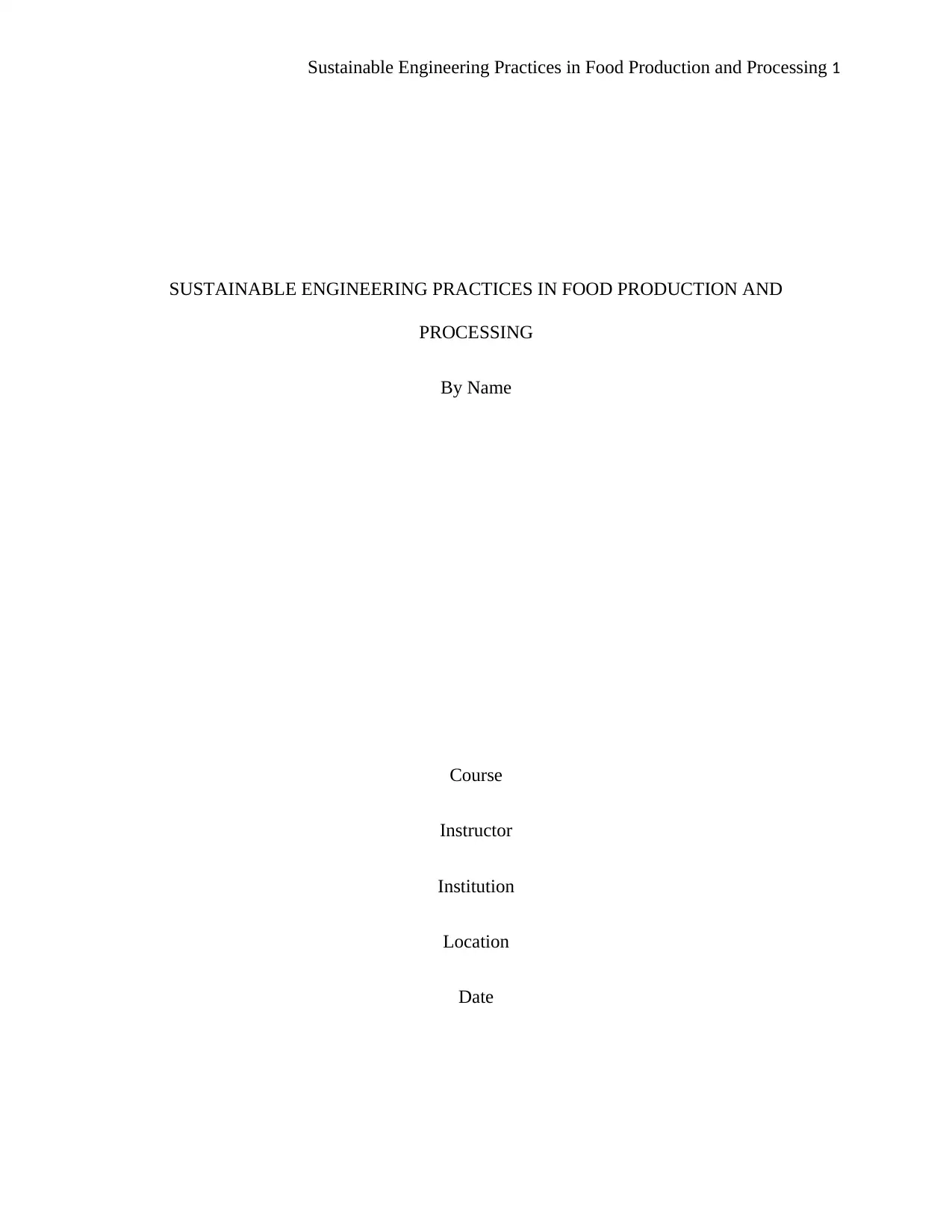
Sustainable Engineering Practices in Food Production and Processing 1
SUSTAINABLE ENGINEERING PRACTICES IN FOOD PRODUCTION AND
PROCESSING
By Name
Course
Instructor
Institution
Location
Date
SUSTAINABLE ENGINEERING PRACTICES IN FOOD PRODUCTION AND
PROCESSING
By Name
Course
Instructor
Institution
Location
Date
Paraphrase This Document
Need a fresh take? Get an instant paraphrase of this document with our AI Paraphraser
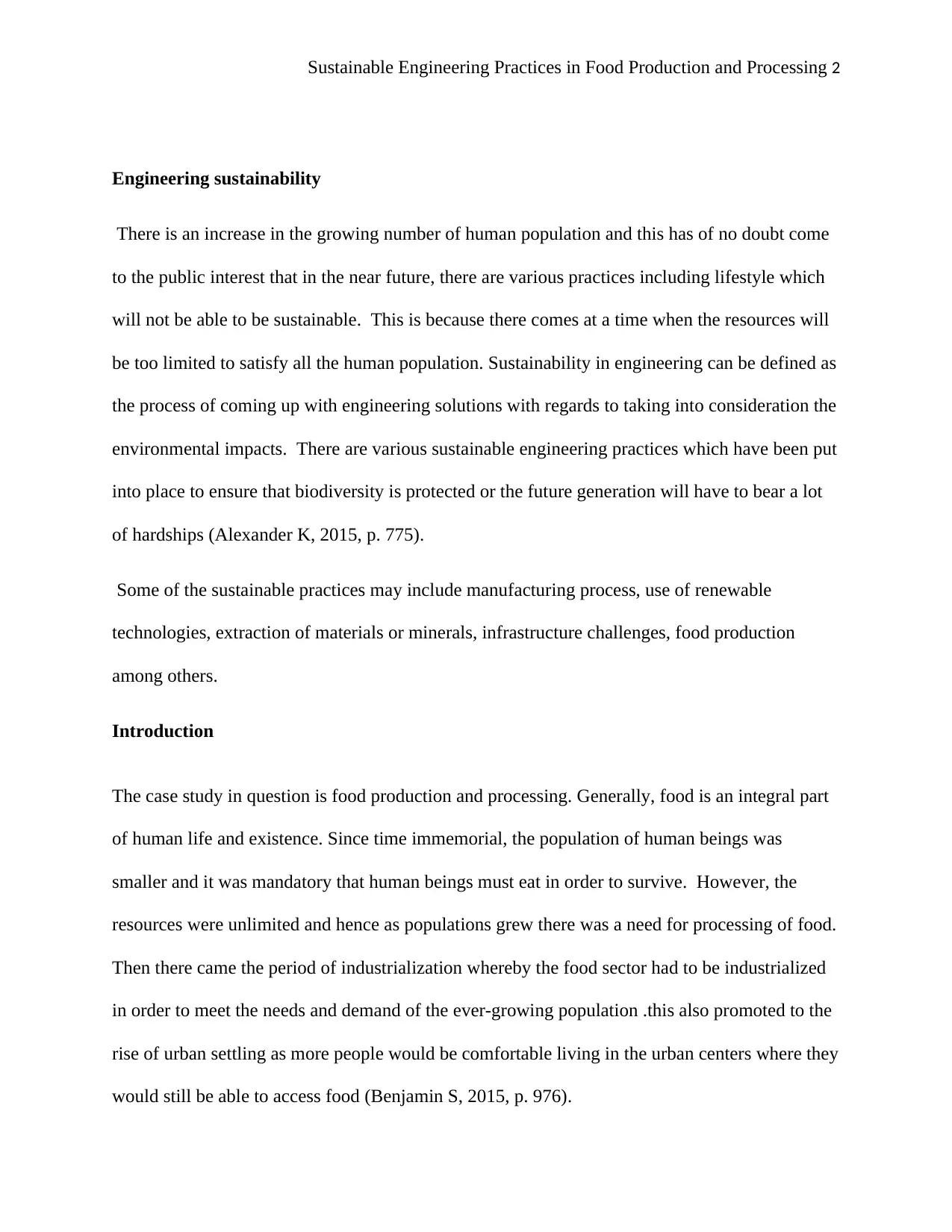
Sustainable Engineering Practices in Food Production and Processing 2
Engineering sustainability
There is an increase in the growing number of human population and this has of no doubt come
to the public interest that in the near future, there are various practices including lifestyle which
will not be able to be sustainable. This is because there comes at a time when the resources will
be too limited to satisfy all the human population. Sustainability in engineering can be defined as
the process of coming up with engineering solutions with regards to taking into consideration the
environmental impacts. There are various sustainable engineering practices which have been put
into place to ensure that biodiversity is protected or the future generation will have to bear a lot
of hardships (Alexander K, 2015, p. 775).
Some of the sustainable practices may include manufacturing process, use of renewable
technologies, extraction of materials or minerals, infrastructure challenges, food production
among others.
Introduction
The case study in question is food production and processing. Generally, food is an integral part
of human life and existence. Since time immemorial, the population of human beings was
smaller and it was mandatory that human beings must eat in order to survive. However, the
resources were unlimited and hence as populations grew there was a need for processing of food.
Then there came the period of industrialization whereby the food sector had to be industrialized
in order to meet the needs and demand of the ever-growing population .this also promoted to the
rise of urban settling as more people would be comfortable living in the urban centers where they
would still be able to access food (Benjamin S, 2015, p. 976).
Engineering sustainability
There is an increase in the growing number of human population and this has of no doubt come
to the public interest that in the near future, there are various practices including lifestyle which
will not be able to be sustainable. This is because there comes at a time when the resources will
be too limited to satisfy all the human population. Sustainability in engineering can be defined as
the process of coming up with engineering solutions with regards to taking into consideration the
environmental impacts. There are various sustainable engineering practices which have been put
into place to ensure that biodiversity is protected or the future generation will have to bear a lot
of hardships (Alexander K, 2015, p. 775).
Some of the sustainable practices may include manufacturing process, use of renewable
technologies, extraction of materials or minerals, infrastructure challenges, food production
among others.
Introduction
The case study in question is food production and processing. Generally, food is an integral part
of human life and existence. Since time immemorial, the population of human beings was
smaller and it was mandatory that human beings must eat in order to survive. However, the
resources were unlimited and hence as populations grew there was a need for processing of food.
Then there came the period of industrialization whereby the food sector had to be industrialized
in order to meet the needs and demand of the ever-growing population .this also promoted to the
rise of urban settling as more people would be comfortable living in the urban centers where they
would still be able to access food (Benjamin S, 2015, p. 976).
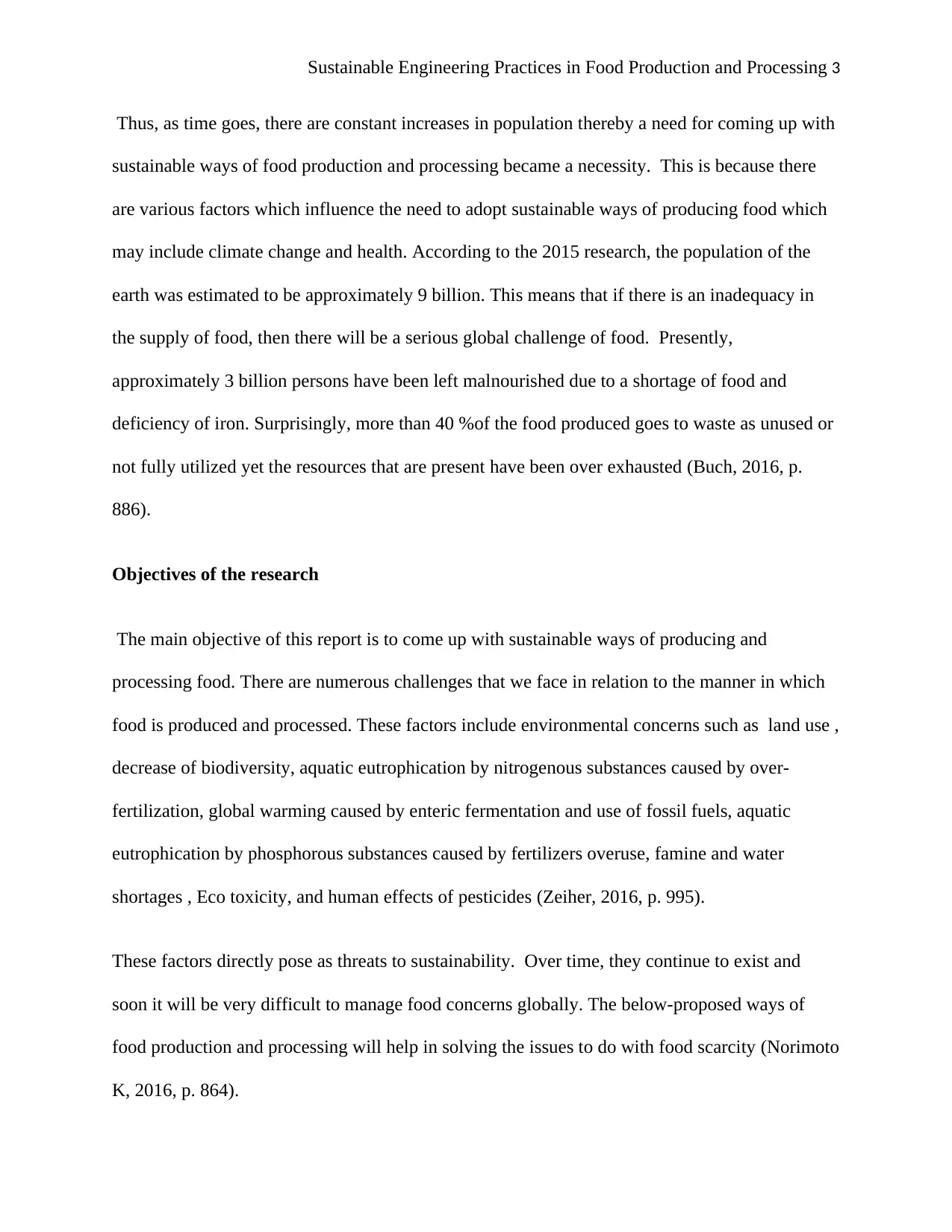
Sustainable Engineering Practices in Food Production and Processing 3
Thus, as time goes, there are constant increases in population thereby a need for coming up with
sustainable ways of food production and processing became a necessity. This is because there
are various factors which influence the need to adopt sustainable ways of producing food which
may include climate change and health. According to the 2015 research, the population of the
earth was estimated to be approximately 9 billion. This means that if there is an inadequacy in
the supply of food, then there will be a serious global challenge of food. Presently,
approximately 3 billion persons have been left malnourished due to a shortage of food and
deficiency of iron. Surprisingly, more than 40 %of the food produced goes to waste as unused or
not fully utilized yet the resources that are present have been over exhausted (Buch, 2016, p.
886).
Objectives of the research
The main objective of this report is to come up with sustainable ways of producing and
processing food. There are numerous challenges that we face in relation to the manner in which
food is produced and processed. These factors include environmental concerns such as land use ,
decrease of biodiversity, aquatic eutrophication by nitrogenous substances caused by over-
fertilization, global warming caused by enteric fermentation and use of fossil fuels, aquatic
eutrophication by phosphorous substances caused by fertilizers overuse, famine and water
shortages , Eco toxicity, and human effects of pesticides (Zeiher, 2016, p. 995).
These factors directly pose as threats to sustainability. Over time, they continue to exist and
soon it will be very difficult to manage food concerns globally. The below-proposed ways of
food production and processing will help in solving the issues to do with food scarcity (Norimoto
K, 2016, p. 864).
Thus, as time goes, there are constant increases in population thereby a need for coming up with
sustainable ways of food production and processing became a necessity. This is because there
are various factors which influence the need to adopt sustainable ways of producing food which
may include climate change and health. According to the 2015 research, the population of the
earth was estimated to be approximately 9 billion. This means that if there is an inadequacy in
the supply of food, then there will be a serious global challenge of food. Presently,
approximately 3 billion persons have been left malnourished due to a shortage of food and
deficiency of iron. Surprisingly, more than 40 %of the food produced goes to waste as unused or
not fully utilized yet the resources that are present have been over exhausted (Buch, 2016, p.
886).
Objectives of the research
The main objective of this report is to come up with sustainable ways of producing and
processing food. There are numerous challenges that we face in relation to the manner in which
food is produced and processed. These factors include environmental concerns such as land use ,
decrease of biodiversity, aquatic eutrophication by nitrogenous substances caused by over-
fertilization, global warming caused by enteric fermentation and use of fossil fuels, aquatic
eutrophication by phosphorous substances caused by fertilizers overuse, famine and water
shortages , Eco toxicity, and human effects of pesticides (Zeiher, 2016, p. 995).
These factors directly pose as threats to sustainability. Over time, they continue to exist and
soon it will be very difficult to manage food concerns globally. The below-proposed ways of
food production and processing will help in solving the issues to do with food scarcity (Norimoto
K, 2016, p. 864).
⊘ This is a preview!⊘
Do you want full access?
Subscribe today to unlock all pages.

Trusted by 1+ million students worldwide
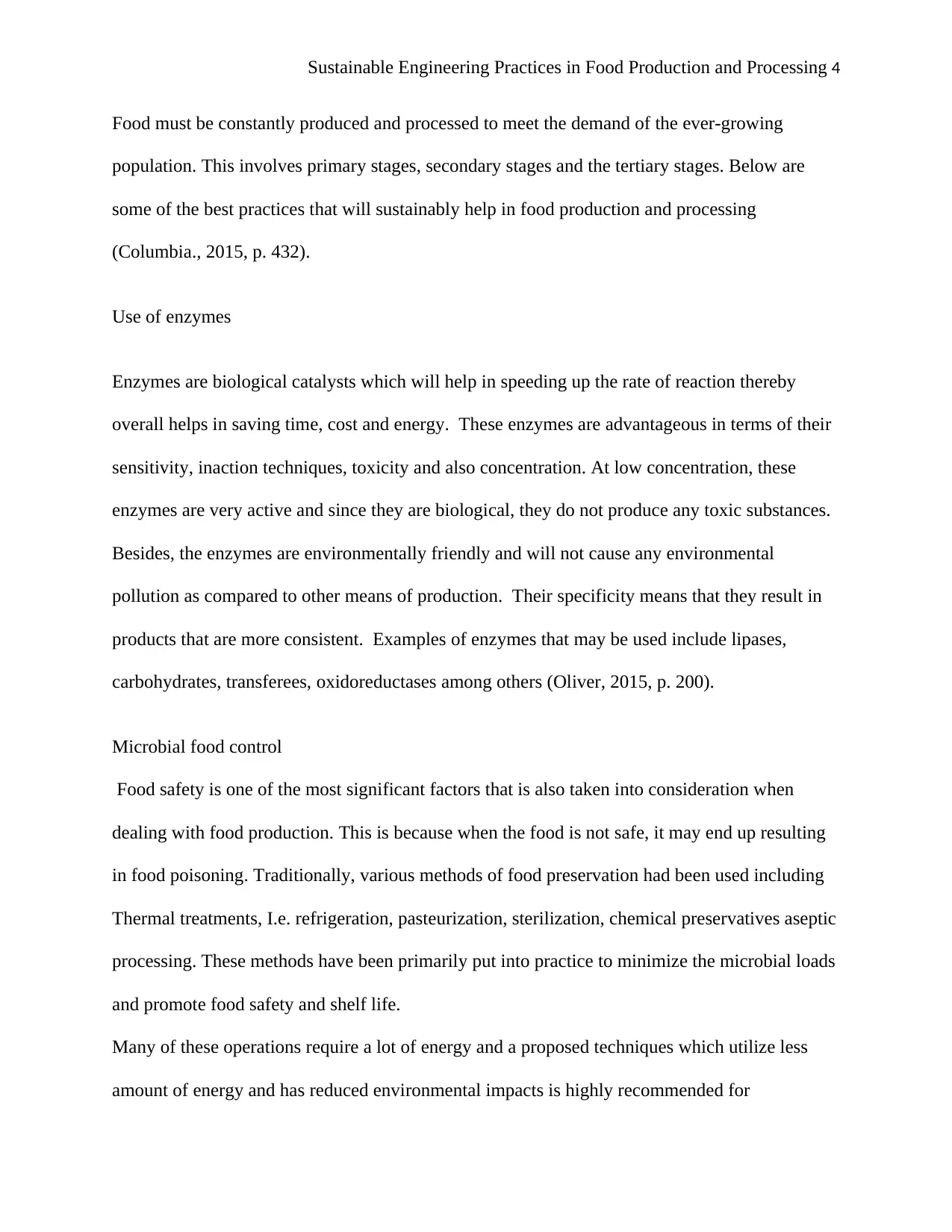
Sustainable Engineering Practices in Food Production and Processing 4
Food must be constantly produced and processed to meet the demand of the ever-growing
population. This involves primary stages, secondary stages and the tertiary stages. Below are
some of the best practices that will sustainably help in food production and processing
(Columbia., 2015, p. 432).
Use of enzymes
Enzymes are biological catalysts which will help in speeding up the rate of reaction thereby
overall helps in saving time, cost and energy. These enzymes are advantageous in terms of their
sensitivity, inaction techniques, toxicity and also concentration. At low concentration, these
enzymes are very active and since they are biological, they do not produce any toxic substances.
Besides, the enzymes are environmentally friendly and will not cause any environmental
pollution as compared to other means of production. Their specificity means that they result in
products that are more consistent. Examples of enzymes that may be used include lipases,
carbohydrates, transferees, oxidoreductases among others (Oliver, 2015, p. 200).
Microbial food control
Food safety is one of the most significant factors that is also taken into consideration when
dealing with food production. This is because when the food is not safe, it may end up resulting
in food poisoning. Traditionally, various methods of food preservation had been used including
Thermal treatments, I.e. refrigeration, pasteurization, sterilization, chemical preservatives aseptic
processing. These methods have been primarily put into practice to minimize the microbial loads
and promote food safety and shelf life.
Many of these operations require a lot of energy and a proposed techniques which utilize less
amount of energy and has reduced environmental impacts is highly recommended for
Food must be constantly produced and processed to meet the demand of the ever-growing
population. This involves primary stages, secondary stages and the tertiary stages. Below are
some of the best practices that will sustainably help in food production and processing
(Columbia., 2015, p. 432).
Use of enzymes
Enzymes are biological catalysts which will help in speeding up the rate of reaction thereby
overall helps in saving time, cost and energy. These enzymes are advantageous in terms of their
sensitivity, inaction techniques, toxicity and also concentration. At low concentration, these
enzymes are very active and since they are biological, they do not produce any toxic substances.
Besides, the enzymes are environmentally friendly and will not cause any environmental
pollution as compared to other means of production. Their specificity means that they result in
products that are more consistent. Examples of enzymes that may be used include lipases,
carbohydrates, transferees, oxidoreductases among others (Oliver, 2015, p. 200).
Microbial food control
Food safety is one of the most significant factors that is also taken into consideration when
dealing with food production. This is because when the food is not safe, it may end up resulting
in food poisoning. Traditionally, various methods of food preservation had been used including
Thermal treatments, I.e. refrigeration, pasteurization, sterilization, chemical preservatives aseptic
processing. These methods have been primarily put into practice to minimize the microbial loads
and promote food safety and shelf life.
Many of these operations require a lot of energy and a proposed techniques which utilize less
amount of energy and has reduced environmental impacts is highly recommended for
Paraphrase This Document
Need a fresh take? Get an instant paraphrase of this document with our AI Paraphraser
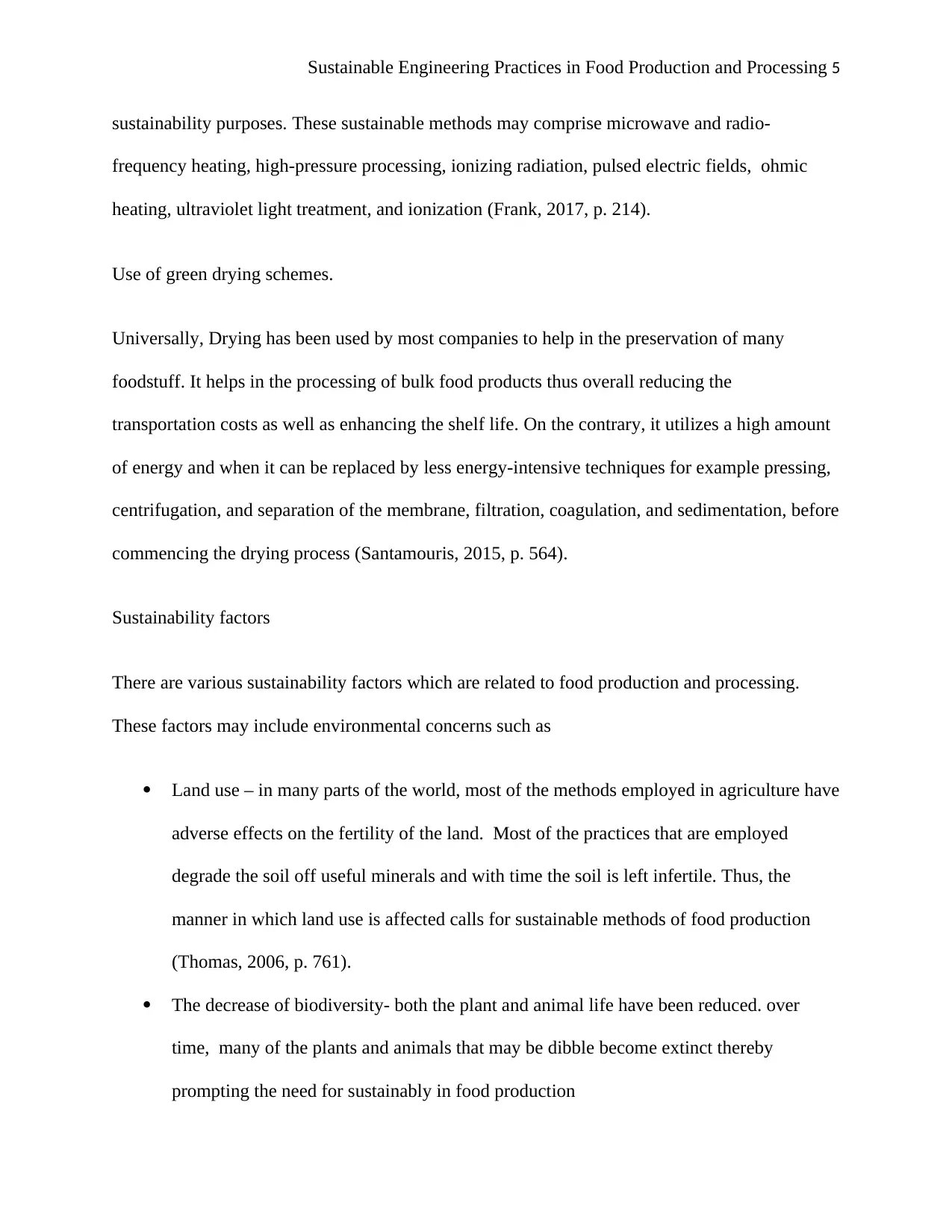
Sustainable Engineering Practices in Food Production and Processing 5
sustainability purposes. These sustainable methods may comprise microwave and radio-
frequency heating, high-pressure processing, ionizing radiation, pulsed electric fields, ohmic
heating, ultraviolet light treatment, and ionization (Frank, 2017, p. 214).
Use of green drying schemes.
Universally, Drying has been used by most companies to help in the preservation of many
foodstuff. It helps in the processing of bulk food products thus overall reducing the
transportation costs as well as enhancing the shelf life. On the contrary, it utilizes a high amount
of energy and when it can be replaced by less energy-intensive techniques for example pressing,
centrifugation, and separation of the membrane, filtration, coagulation, and sedimentation, before
commencing the drying process (Santamouris, 2015, p. 564).
Sustainability factors
There are various sustainability factors which are related to food production and processing.
These factors may include environmental concerns such as
Land use – in many parts of the world, most of the methods employed in agriculture have
adverse effects on the fertility of the land. Most of the practices that are employed
degrade the soil off useful minerals and with time the soil is left infertile. Thus, the
manner in which land use is affected calls for sustainable methods of food production
(Thomas, 2006, p. 761).
The decrease of biodiversity- both the plant and animal life have been reduced. over
time, many of the plants and animals that may be dibble become extinct thereby
prompting the need for sustainably in food production
sustainability purposes. These sustainable methods may comprise microwave and radio-
frequency heating, high-pressure processing, ionizing radiation, pulsed electric fields, ohmic
heating, ultraviolet light treatment, and ionization (Frank, 2017, p. 214).
Use of green drying schemes.
Universally, Drying has been used by most companies to help in the preservation of many
foodstuff. It helps in the processing of bulk food products thus overall reducing the
transportation costs as well as enhancing the shelf life. On the contrary, it utilizes a high amount
of energy and when it can be replaced by less energy-intensive techniques for example pressing,
centrifugation, and separation of the membrane, filtration, coagulation, and sedimentation, before
commencing the drying process (Santamouris, 2015, p. 564).
Sustainability factors
There are various sustainability factors which are related to food production and processing.
These factors may include environmental concerns such as
Land use – in many parts of the world, most of the methods employed in agriculture have
adverse effects on the fertility of the land. Most of the practices that are employed
degrade the soil off useful minerals and with time the soil is left infertile. Thus, the
manner in which land use is affected calls for sustainable methods of food production
(Thomas, 2006, p. 761).
The decrease of biodiversity- both the plant and animal life have been reduced. over
time, many of the plants and animals that may be dibble become extinct thereby
prompting the need for sustainably in food production
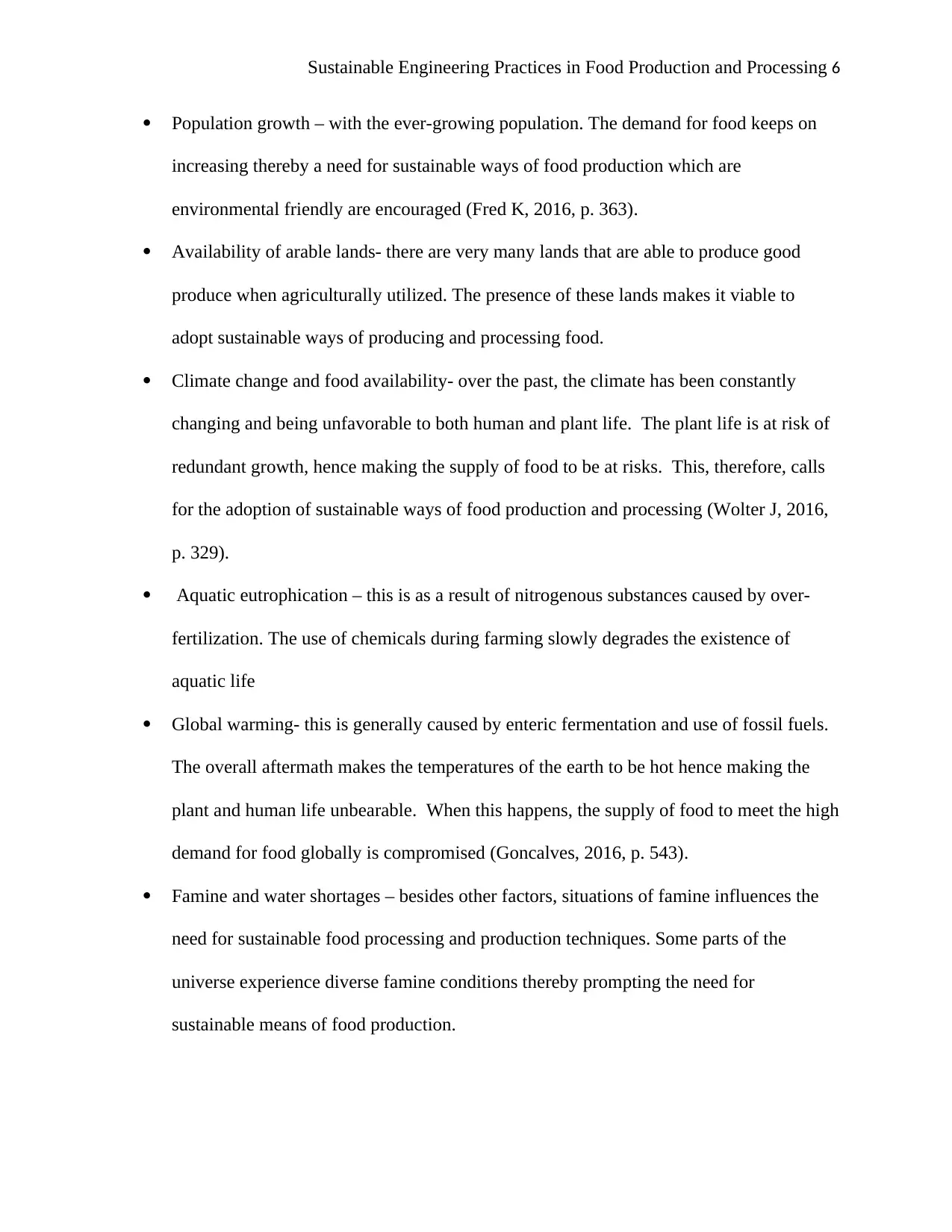
Sustainable Engineering Practices in Food Production and Processing 6
Population growth – with the ever-growing population. The demand for food keeps on
increasing thereby a need for sustainable ways of food production which are
environmental friendly are encouraged (Fred K, 2016, p. 363).
Availability of arable lands- there are very many lands that are able to produce good
produce when agriculturally utilized. The presence of these lands makes it viable to
adopt sustainable ways of producing and processing food.
Climate change and food availability- over the past, the climate has been constantly
changing and being unfavorable to both human and plant life. The plant life is at risk of
redundant growth, hence making the supply of food to be at risks. This, therefore, calls
for the adoption of sustainable ways of food production and processing (Wolter J, 2016,
p. 329).
Aquatic eutrophication – this is as a result of nitrogenous substances caused by over-
fertilization. The use of chemicals during farming slowly degrades the existence of
aquatic life
Global warming- this is generally caused by enteric fermentation and use of fossil fuels.
The overall aftermath makes the temperatures of the earth to be hot hence making the
plant and human life unbearable. When this happens, the supply of food to meet the high
demand for food globally is compromised (Goncalves, 2016, p. 543).
Famine and water shortages – besides other factors, situations of famine influences the
need for sustainable food processing and production techniques. Some parts of the
universe experience diverse famine conditions thereby prompting the need for
sustainable means of food production.
Population growth – with the ever-growing population. The demand for food keeps on
increasing thereby a need for sustainable ways of food production which are
environmental friendly are encouraged (Fred K, 2016, p. 363).
Availability of arable lands- there are very many lands that are able to produce good
produce when agriculturally utilized. The presence of these lands makes it viable to
adopt sustainable ways of producing and processing food.
Climate change and food availability- over the past, the climate has been constantly
changing and being unfavorable to both human and plant life. The plant life is at risk of
redundant growth, hence making the supply of food to be at risks. This, therefore, calls
for the adoption of sustainable ways of food production and processing (Wolter J, 2016,
p. 329).
Aquatic eutrophication – this is as a result of nitrogenous substances caused by over-
fertilization. The use of chemicals during farming slowly degrades the existence of
aquatic life
Global warming- this is generally caused by enteric fermentation and use of fossil fuels.
The overall aftermath makes the temperatures of the earth to be hot hence making the
plant and human life unbearable. When this happens, the supply of food to meet the high
demand for food globally is compromised (Goncalves, 2016, p. 543).
Famine and water shortages – besides other factors, situations of famine influences the
need for sustainable food processing and production techniques. Some parts of the
universe experience diverse famine conditions thereby prompting the need for
sustainable means of food production.
⊘ This is a preview!⊘
Do you want full access?
Subscribe today to unlock all pages.

Trusted by 1+ million students worldwide
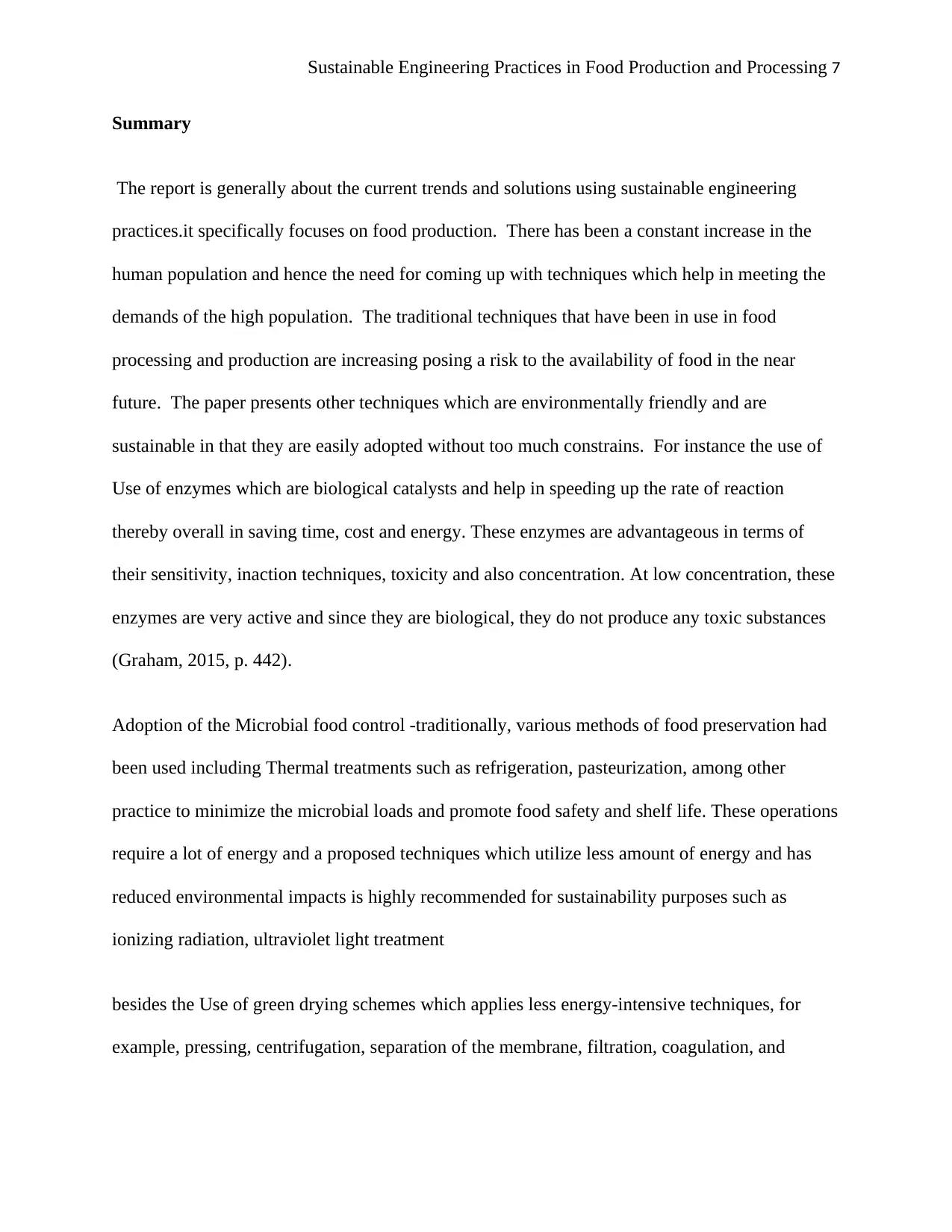
Sustainable Engineering Practices in Food Production and Processing 7
Summary
The report is generally about the current trends and solutions using sustainable engineering
practices.it specifically focuses on food production. There has been a constant increase in the
human population and hence the need for coming up with techniques which help in meeting the
demands of the high population. The traditional techniques that have been in use in food
processing and production are increasing posing a risk to the availability of food in the near
future. The paper presents other techniques which are environmentally friendly and are
sustainable in that they are easily adopted without too much constrains. For instance the use of
Use of enzymes which are biological catalysts and help in speeding up the rate of reaction
thereby overall in saving time, cost and energy. These enzymes are advantageous in terms of
their sensitivity, inaction techniques, toxicity and also concentration. At low concentration, these
enzymes are very active and since they are biological, they do not produce any toxic substances
(Graham, 2015, p. 442).
Adoption of the Microbial food control -traditionally, various methods of food preservation had
been used including Thermal treatments such as refrigeration, pasteurization, among other
practice to minimize the microbial loads and promote food safety and shelf life. These operations
require a lot of energy and a proposed techniques which utilize less amount of energy and has
reduced environmental impacts is highly recommended for sustainability purposes such as
ionizing radiation, ultraviolet light treatment
besides the Use of green drying schemes which applies less energy-intensive techniques, for
example, pressing, centrifugation, separation of the membrane, filtration, coagulation, and
Summary
The report is generally about the current trends and solutions using sustainable engineering
practices.it specifically focuses on food production. There has been a constant increase in the
human population and hence the need for coming up with techniques which help in meeting the
demands of the high population. The traditional techniques that have been in use in food
processing and production are increasing posing a risk to the availability of food in the near
future. The paper presents other techniques which are environmentally friendly and are
sustainable in that they are easily adopted without too much constrains. For instance the use of
Use of enzymes which are biological catalysts and help in speeding up the rate of reaction
thereby overall in saving time, cost and energy. These enzymes are advantageous in terms of
their sensitivity, inaction techniques, toxicity and also concentration. At low concentration, these
enzymes are very active and since they are biological, they do not produce any toxic substances
(Graham, 2015, p. 442).
Adoption of the Microbial food control -traditionally, various methods of food preservation had
been used including Thermal treatments such as refrigeration, pasteurization, among other
practice to minimize the microbial loads and promote food safety and shelf life. These operations
require a lot of energy and a proposed techniques which utilize less amount of energy and has
reduced environmental impacts is highly recommended for sustainability purposes such as
ionizing radiation, ultraviolet light treatment
besides the Use of green drying schemes which applies less energy-intensive techniques, for
example, pressing, centrifugation, separation of the membrane, filtration, coagulation, and
Paraphrase This Document
Need a fresh take? Get an instant paraphrase of this document with our AI Paraphraser
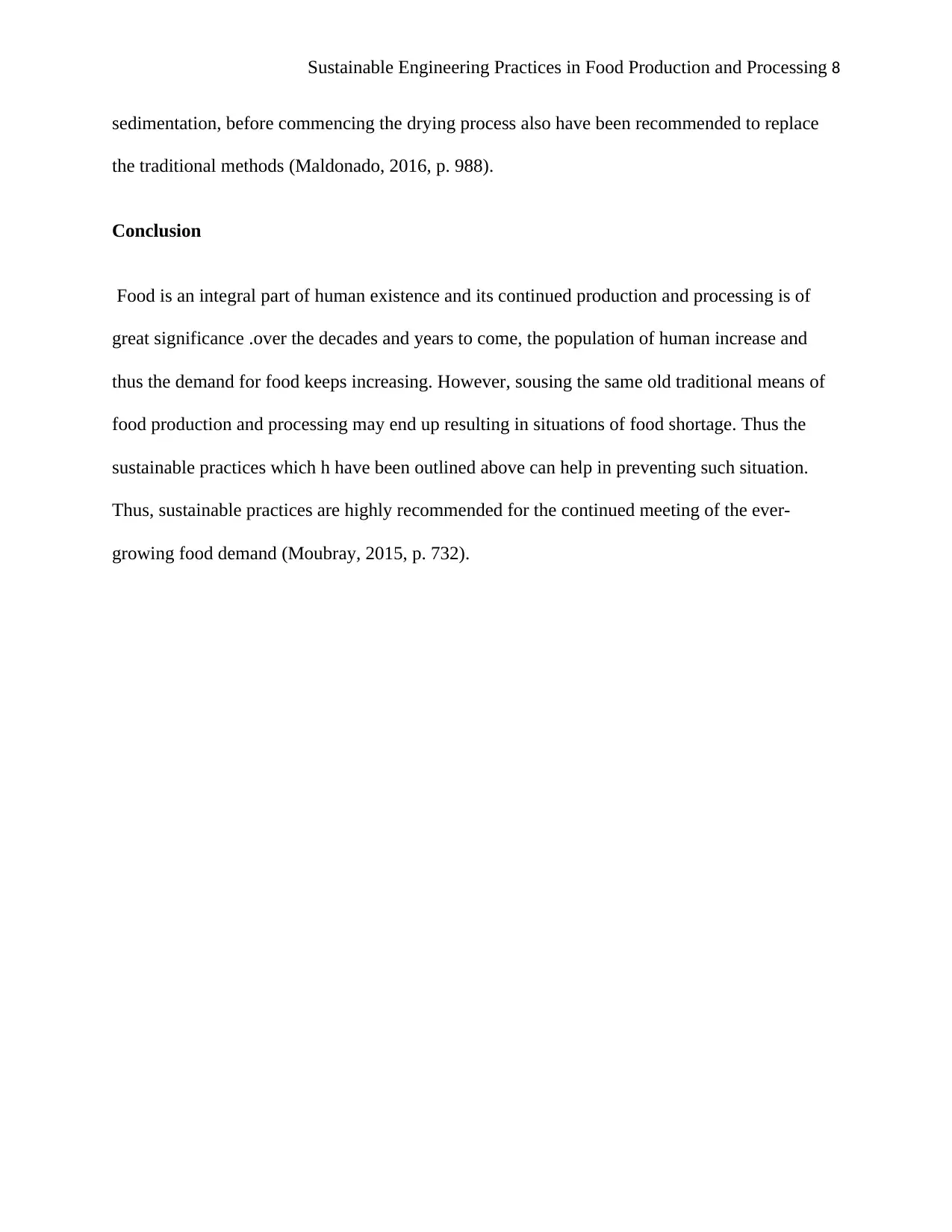
Sustainable Engineering Practices in Food Production and Processing 8
sedimentation, before commencing the drying process also have been recommended to replace
the traditional methods (Maldonado, 2016, p. 988).
Conclusion
Food is an integral part of human existence and its continued production and processing is of
great significance .over the decades and years to come, the population of human increase and
thus the demand for food keeps increasing. However, sousing the same old traditional means of
food production and processing may end up resulting in situations of food shortage. Thus the
sustainable practices which h have been outlined above can help in preventing such situation.
Thus, sustainable practices are highly recommended for the continued meeting of the ever-
growing food demand (Moubray, 2015, p. 732).
sedimentation, before commencing the drying process also have been recommended to replace
the traditional methods (Maldonado, 2016, p. 988).
Conclusion
Food is an integral part of human existence and its continued production and processing is of
great significance .over the decades and years to come, the population of human increase and
thus the demand for food keeps increasing. However, sousing the same old traditional means of
food production and processing may end up resulting in situations of food shortage. Thus the
sustainable practices which h have been outlined above can help in preventing such situation.
Thus, sustainable practices are highly recommended for the continued meeting of the ever-
growing food demand (Moubray, 2015, p. 732).
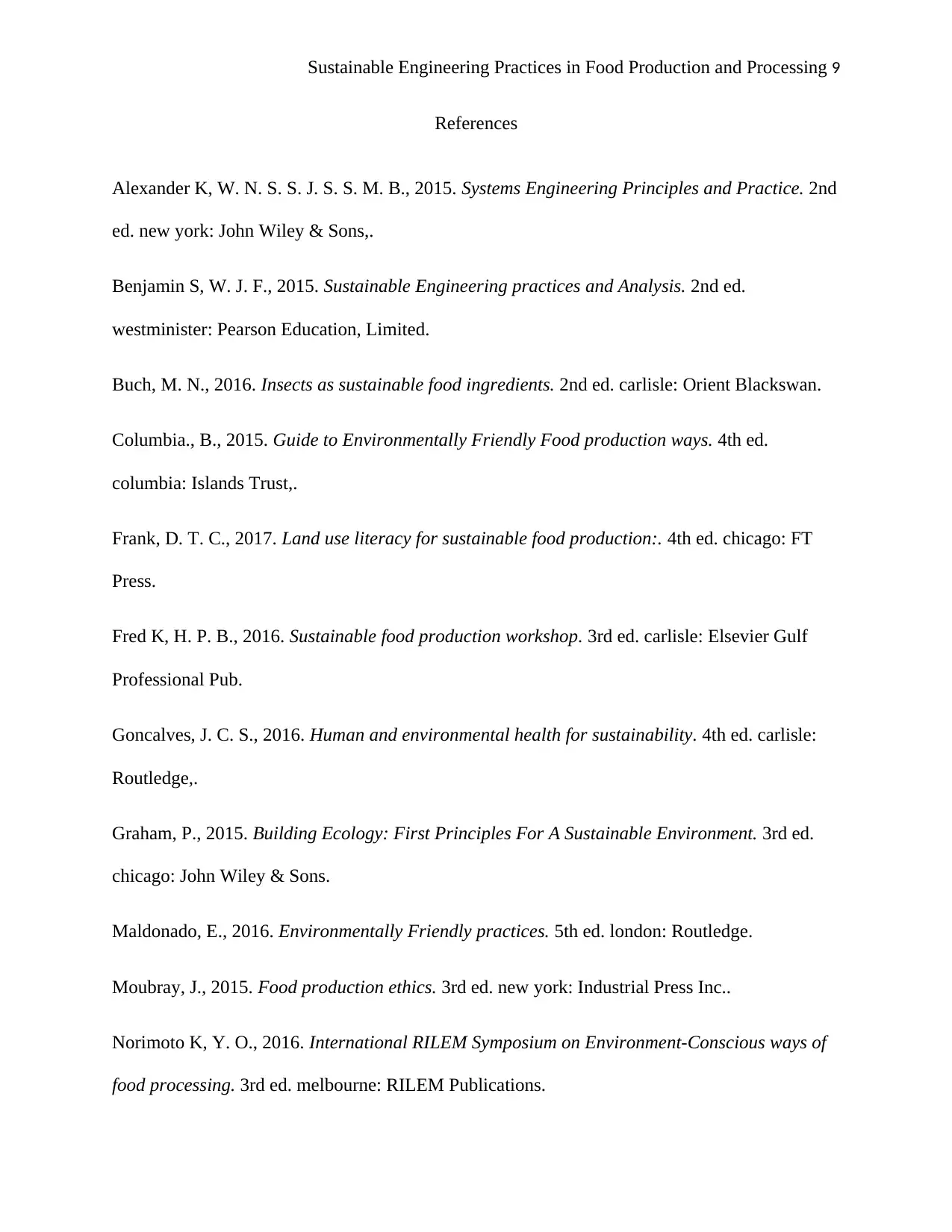
Sustainable Engineering Practices in Food Production and Processing 9
References
Alexander K, W. N. S. S. J. S. S. M. B., 2015. Systems Engineering Principles and Practice. 2nd
ed. new york: John Wiley & Sons,.
Benjamin S, W. J. F., 2015. Sustainable Engineering practices and Analysis. 2nd ed.
westminister: Pearson Education, Limited.
Buch, M. N., 2016. Insects as sustainable food ingredients. 2nd ed. carlisle: Orient Blackswan.
Columbia., B., 2015. Guide to Environmentally Friendly Food production ways. 4th ed.
columbia: Islands Trust,.
Frank, D. T. C., 2017. Land use literacy for sustainable food production:. 4th ed. chicago: FT
Press.
Fred K, H. P. B., 2016. Sustainable food production workshop. 3rd ed. carlisle: Elsevier Gulf
Professional Pub.
Goncalves, J. C. S., 2016. Human and environmental health for sustainability. 4th ed. carlisle:
Routledge,.
Graham, P., 2015. Building Ecology: First Principles For A Sustainable Environment. 3rd ed.
chicago: John Wiley & Sons.
Maldonado, E., 2016. Environmentally Friendly practices. 5th ed. london: Routledge.
Moubray, J., 2015. Food production ethics. 3rd ed. new york: Industrial Press Inc..
Norimoto K, Y. O., 2016. International RILEM Symposium on Environment-Conscious ways of
food processing. 3rd ed. melbourne: RILEM Publications.
References
Alexander K, W. N. S. S. J. S. S. M. B., 2015. Systems Engineering Principles and Practice. 2nd
ed. new york: John Wiley & Sons,.
Benjamin S, W. J. F., 2015. Sustainable Engineering practices and Analysis. 2nd ed.
westminister: Pearson Education, Limited.
Buch, M. N., 2016. Insects as sustainable food ingredients. 2nd ed. carlisle: Orient Blackswan.
Columbia., B., 2015. Guide to Environmentally Friendly Food production ways. 4th ed.
columbia: Islands Trust,.
Frank, D. T. C., 2017. Land use literacy for sustainable food production:. 4th ed. chicago: FT
Press.
Fred K, H. P. B., 2016. Sustainable food production workshop. 3rd ed. carlisle: Elsevier Gulf
Professional Pub.
Goncalves, J. C. S., 2016. Human and environmental health for sustainability. 4th ed. carlisle:
Routledge,.
Graham, P., 2015. Building Ecology: First Principles For A Sustainable Environment. 3rd ed.
chicago: John Wiley & Sons.
Maldonado, E., 2016. Environmentally Friendly practices. 5th ed. london: Routledge.
Moubray, J., 2015. Food production ethics. 3rd ed. new york: Industrial Press Inc..
Norimoto K, Y. O., 2016. International RILEM Symposium on Environment-Conscious ways of
food processing. 3rd ed. melbourne: RILEM Publications.
⊘ This is a preview!⊘
Do you want full access?
Subscribe today to unlock all pages.

Trusted by 1+ million students worldwide
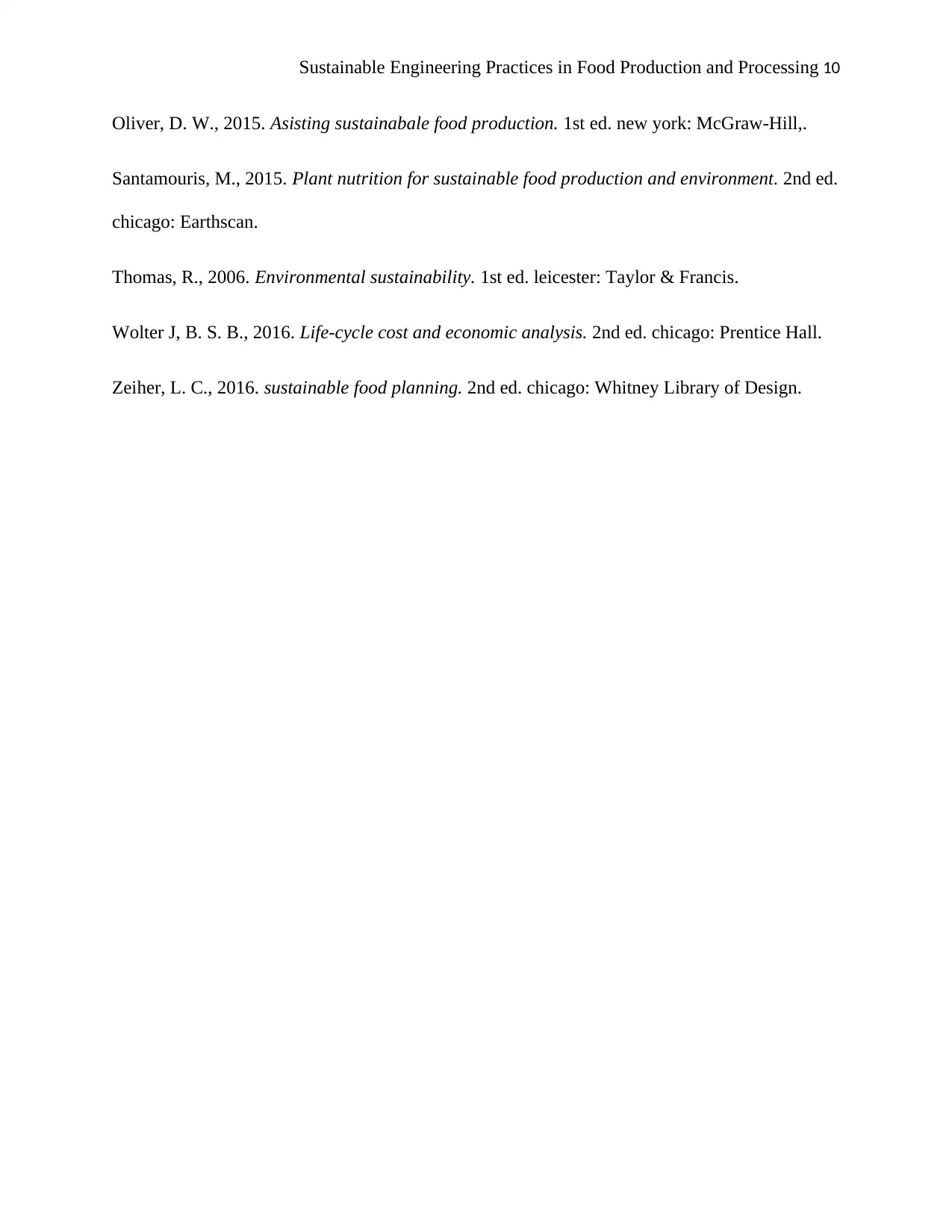
Sustainable Engineering Practices in Food Production and Processing 10
Oliver, D. W., 2015. Asisting sustainabale food production. 1st ed. new york: McGraw-Hill,.
Santamouris, M., 2015. Plant nutrition for sustainable food production and environment. 2nd ed.
chicago: Earthscan.
Thomas, R., 2006. Environmental sustainability. 1st ed. leicester: Taylor & Francis.
Wolter J, B. S. B., 2016. Life-cycle cost and economic analysis. 2nd ed. chicago: Prentice Hall.
Zeiher, L. C., 2016. sustainable food planning. 2nd ed. chicago: Whitney Library of Design.
Oliver, D. W., 2015. Asisting sustainabale food production. 1st ed. new york: McGraw-Hill,.
Santamouris, M., 2015. Plant nutrition for sustainable food production and environment. 2nd ed.
chicago: Earthscan.
Thomas, R., 2006. Environmental sustainability. 1st ed. leicester: Taylor & Francis.
Wolter J, B. S. B., 2016. Life-cycle cost and economic analysis. 2nd ed. chicago: Prentice Hall.
Zeiher, L. C., 2016. sustainable food planning. 2nd ed. chicago: Whitney Library of Design.
1 out of 10
Related Documents
Your All-in-One AI-Powered Toolkit for Academic Success.
+13062052269
info@desklib.com
Available 24*7 on WhatsApp / Email
![[object Object]](/_next/static/media/star-bottom.7253800d.svg)
Unlock your academic potential
Copyright © 2020–2025 A2Z Services. All Rights Reserved. Developed and managed by ZUCOL.





